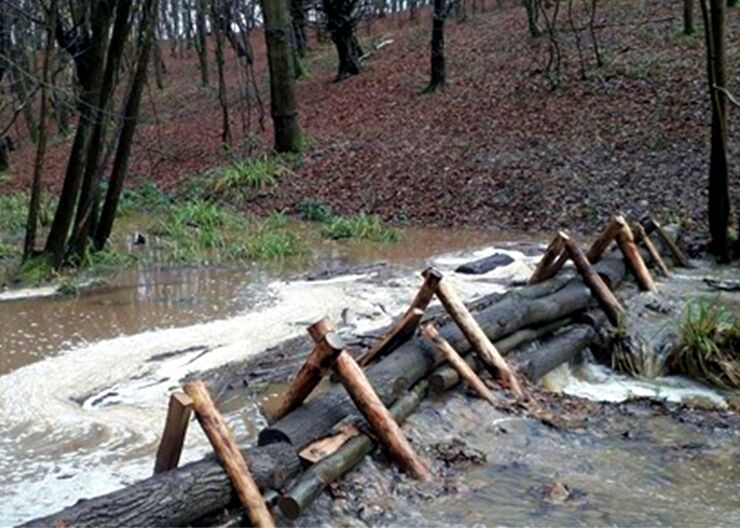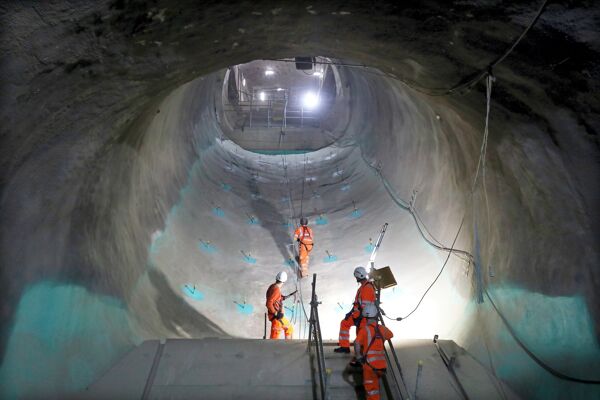
By Simon Fullalove
Essex County Council has used NEC to procure a natural flood management scheme that was built using just logs and horses. A total of 10 ‘leaky dams’ were installed across upper-catchment watercourses in Thorndon Country Park near Brentwood to reduce flood risk to 40 downstream homes in West Thorndon.
The 141 ha park is a site of special scientific interest with significant areas of ancient woodland and a grade II listed parkland, which meant there were restrictions on the materials and methods that could be used. In addition to specifying locally sourced timber, the council decided to minimise the impact of construction by requiring horses to transport the logs rather than mechanical plant. Following a competitive tender, the two-month scheme was let to Hawthorn Heavy Horses under a £52,000 NEC3 Engineering and Construction (ECC) Option C contract in October 2019.
The dams are simple timber structures installed across the watercourses, with seven upstream of Old Hall Pond and a further three downstream. They all allow normal flows to pass through them but retain water during high rainfall, creating localised storage ponds. This has reduced the speed and volume of water flowing down to West Thorndon, reducing the risk of flooding.
The timber was mostly fallen ash from the park together with some locally sourced oak. The main logs were shaped and, using a Suffolk Punch horse, dragged into position and fixed with hand-augured timber stakes. Solar-powered water-level sensors were then installed next to some of the dams for remote monitoring.
The project was delivered on time and within budget by the council’s flood and water management team, with funding provided by the Environment Agency through the Anglian Eastern Regional Flood and Coastal Committee.
Clarity and transparency
Project delivery manager and NEC project manager David Chapman says, ‘As a lead local flood authority, Essex County Council is responsible for managing the risk of flooding from surface water. We do this through surface water management plans, which identify catchments at high risk called critical drainage areas. Once these are identified, we explore the possibility of delivering a flood alleviation scheme to mitigate flood risk in the area.
‘One such catchment encompassed West Horndon, which had experienced significant flooding historically from overland flows and overloaded surface water sewers. As such we investigated the area further and determined that a viable scheme could be implemented to reduce future risks within the upper hydraulic catchment in Thorndon Country Park.’
He says the council’s capital flood alleviation programme has so far delivered over £16 million worth of capital schemes designed to reduce surface water flood risk. ‘We have used NEC ECC Option C on many different projects in the programme over the past six years and found the NEC target cost arrangement works well, which is why we adopted it for Thorndon.
'It gives us the ability to reject or renegotiate prices that we have queried, but it also gives our contractors the confidence of knowing there is a clear and transparent process for supporting and implementing any changes to the NEC works information.’
According to Chapman, the NEC early warning process is also a major benefit. ‘On the Thorndon contract, there were early warning notifications for things such as bad weather or additional material required, and the auditable process made this easy to track.’
The Thorndon scheme was successfully completed in November 2019 and is expected to provide whole-life benefits of nearly £140,000 in damages avoided to downstream properties and the wider economy in West Horndon. It was shortlisted for the Climate Resilience Project of the Year in the 2020 British Construction Industry Awards.
Benefits of using NEC
- Transparency in ECC Option C gave the client full control over pricing but also ensured the contractor was fairly rewarded for changes.
- NEC early warning process meant issues were flagged up at the earliest opportunity to help ensure successful delivery on time and on budget.
- NEC obligation for parties to work in a ‘spirit of mutual trust and co-operation’ promoted collaborative working, leading to more efficient delivery.



